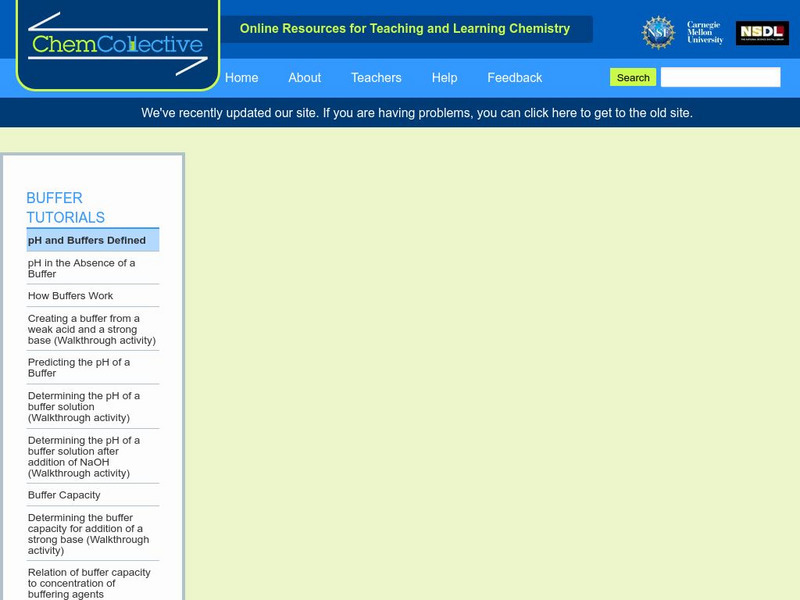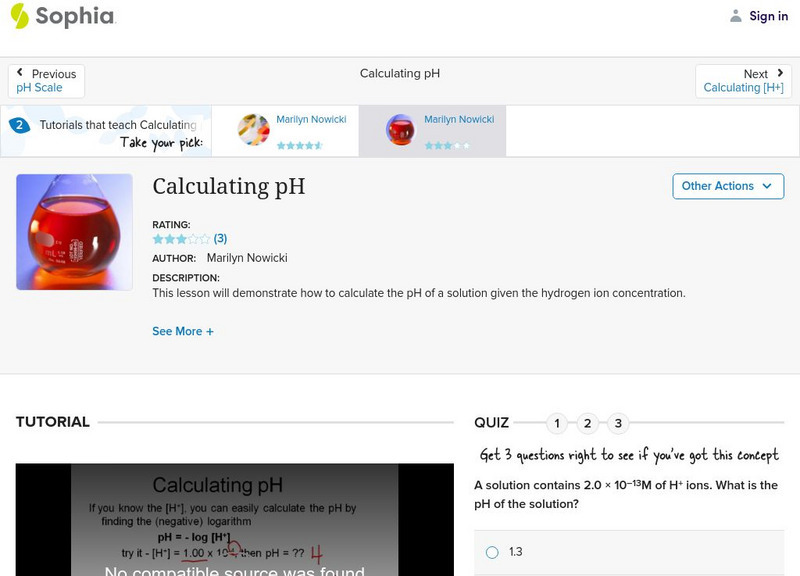Hi, what do you want to do?
Curated OER
Organic Chemistry II Exam 3
In this chemistry worksheet, students determine which compound is the most acidic in each multiple choice question. Then they determine what the major product would be in each of the reactions stated on the sheet.
Curated OER
Acids/Bases and Buffers
In this acids, bases and buffers worksheet, students define terms, solve problems such as calculating the pH of solutions and the molarity of solutions and they write balanced equations of neutralization reactions.
Curated OER
pH of Solutions
In this pH activity, students describe the pH scale and explain the initials "pH." Kids classify solutions as acidic, neutral, or basic. Students name compounds as acids or bases. This activity has 3 short answer questions and 5 fill in...
Curated OER
What Are Acids And Bases?
In this acids and bases worksheet, students will complete a Venn diagram by comparing and contrasting the characteristics of acids and bases.
Curated OER
Reactions of Benzene
In this chemistry worksheet, students write the products for each of the given reactions. Then they write N.R. if there is no reaction present. There are eight reactions to identify on the sheet.
Curated OER
Hydrolysis
In this hydrolysis worksheet, students write dissociation equations for the given salts and determine if the salt is acidic, basic, or neutral. This worksheet has 6 fill in the blank questions and 4 problems to solve.
Curated OER
Chemical Reactions
In this chemical reactions instructional activity, students determine if solutions are acidic, basic, or neutral. Students give reactions' molecular equations and ionic equations. This instructional activity has 14 problems to solve.
Curated OER
Experiment: How acidic is rain in your area?
Students collect water samples from around your home and school, check the pH level of each water sample, and record the pH levels in a chart that looks something like this:
American Chemical Society
Middle School Chemistry: Chapter 6: Chemical Change
Twelve interactive chemistry lessons about chemical changes complete with handouts and animations.
Climate Literacy
Clean: Effects of Increased Co2 in the Air on Seawater and Distilled Water
Students perform an experiment comparing the impacts of CO2 on salt water and on fresh water. In a short demonstration, students examine how distilled water and seawater are affected differently by increasing carbon dioxide in the air.
CK-12 Foundation
Ck 12: Salt Solutions
[Free Registration/Login may be required to access all resource tools.] Students begin by predicting whether a salt solution is acidic, basic, or neutral, and then practice writing balanced equations for hydrolysis reactions. They also...
CK-12 Foundation
Ck 12: Acids and Bases
[Free Registration/Login may be required to access all resource tools.] In this learning module, students investigate the different chemical and physical properties of acids and bases.
Chemistry Collective
Chem Collective: Current Collection of Virtual Lab Problems
A collection of over 30 virtual chemistry problems with accompanying interactive activities. Each problem includes a word file for potential differentiation in your classroom.
Chemistry Collective
Chem Collective: P H and Buffers Defined
This tutorial presents a review of the definitions for pH and buffer solutions
Khan Academy
Khan Academy: Bronsted Lowry Acid Base Theory
Understand the definition of Bronsted-Lowry acids and bases, strong and weak acids and bases, and how to identify conjugate acid-base pairs.
PBS
Pbs Learning Media: Acids and Bases: Cabbage Juice Indicator
In this video segment, the ZOOM cast demonstrates how to use cabbage juice to find out if a solution is an acid or a base.
TOPS Learning Systems
Tops Learning Systems: Top Science: Cabbage Chemistry [Pdf]
Experiment using water from boiling red cabbage to determine if a material is an acid, a base, or neutral.
Chem4kids
Chem4 Kids: Reactions: Names to Know
Acids and bases are scaled. These facts are good knowledge to have when classifying solutions as acidic, basic, or neutral.
American Chemical Society
Middle School Chemistry: Co2 Reacting With Water
See how carbon dioxide reacts with water to produce carbonic acid.
Center of Science and Industry
Cosi Columbus: Cabbage Patch Chemistry [Pdf]
Make your own indicator by using red cabbage leaves and common household items. Includes full list of materials, procedures, and scientific explanation of how to determine if a substance is acidic, basic, or neutral based on the colors...
Sophia Learning
Sophia: Calculating P H
A video tutorial demonstrating how to calculate the pH of a solution given the hydrogen ion concentration. [3:44]
Sophia Learning
Sophia: P H Scale
A video tutorial introducing the pH scale as a representation of the concentration of protons. [4:45]
US Environmental Protection Agency
Epa: Measuring Soil P H
This site has an experiment to find out how to measure the pH of your soil. The soil pH is an important condition that can affect the health of plants and animals.
US Environmental Protection Agency
Epa: Measuring the P H of Natural Water
How acidic is your water? "In this experiment, you will measure the pH of natural water located near your home or school."





















![Cosi Columbus: Cabbage Patch Chemistry [Pdf] Activity Cosi Columbus: Cabbage Patch Chemistry [Pdf] Activity](http://lessonplanet.com/content/resources/thumbnails/410122/large/bwluav9tywdpy2symdiwmduymc0ynde4oc0xzxmzchv6lmpwzw.jpg?1589985500)



